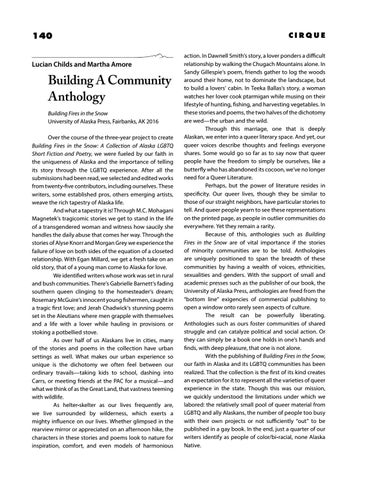140 Lucian Childs and Martha Amore
Building A Community Anthology Building Fires in the Snow University of Alaska Press, Fairbanks, AK 2016
Over the course of the three-year project to create Building Fires in the Snow: A Collection of Alaska LGBTQ Short Fiction and Poetry, we were fueled by our faith in the uniqueness of Alaska and the importance of telling its story through the LGBTQ experience. After all the submissions had been read, we selected and edited works from twenty-five contributors, including ourselves. These writers, some established pros, others emerging artists, weave the rich tapestry of Alaska life. And what a tapestry it is! Through M.C. Mohagani Magnetek’s tragicomic stories we get to stand in the life of a transgendered woman and witness how saucily she handles the daily abuse that comes her way. Through the stories of Alyse Knorr and Morgan Grey we experience the failure of love on both sides of the equation of a closeted relationship. With Egan Millard, we get a fresh take on an old story, that of a young man come to Alaska for love. We identified writers whose work was set in rural and bush communities. There’s Gabrielle Barnett’s fading southern queen clinging to the homesteader’s dream; Rosemary McGuire’s innocent young fishermen, caught in a tragic first love; and Jerah Chadwick’s stunning poems set in the Aleutians where men grapple with themselves and a life with a lover while hauling in provisions or stoking a potbellied stove. As over half of us Alaskans live in cities, many of the stories and poems in the collection have urban settings as well. What makes our urban experience so unique is the dichotomy we often feel between our ordinary travails—taking kids to school, dashing into Carrs, or meeting friends at the PAC for a musical—and what we think of as the Great Land, that vastness teeming with wildlife. As helter-skelter as our lives frequently are, we live surrounded by wilderness, which exerts a mighty influence on our lives. Whether glimpsed in the rearview mirror or appreciated on an afternoon hike, the characters in these stories and poems look to nature for inspiration, comfort, and even models of harmonious
CIRQUE action. In Dawnell Smith’s story, a lover ponders a difficult relationship by walking the Chugach Mountains alone. In Sandy Gillespie’s poem, friends gather to log the woods around their home, not to dominate the landscape, but to build a lovers’ cabin. In Teeka Ballas’s story, a woman watches her lover cook ptarmigan while musing on their lifestyle of hunting, fishing, and harvesting vegetables. In these stories and poems, the two halves of the dichotomy are wed—the urban and the wild. Through this marriage, one that is deeply Alaskan, we enter into a queer literary space. And yet, our queer voices describe thoughts and feelings everyone shares. Some would go so far as to say now that queer people have the freedom to simply be ourselves, like a butterfly who has abandoned its cocoon, we’ve no longer need for a Queer Literature. Perhaps, but the power of literature resides in specificity. Our queer lives, though they be similar to those of our straight neighbors, have particular stories to tell. And queer people yearn to see these representations on the printed page, as people in outlier communities do everywhere. Yet they remain a rarity. Because of this, anthologies such as Building Fires in the Snow are of vital importance if the stories of minority communities are to be told. Anthologies are uniquely positioned to span the breadth of these communities by having a wealth of voices, ethnicities, sexualities and genders. With the support of small and academic presses such as the publisher of our book, the University of Alaska Press, anthologies are freed from the “bottom line” exigencies of commercial publishing to open a window onto rarely seen aspects of culture. The result can be powerfully liberating. Anthologies such as ours foster communities of shared struggle and can catalyze political and social action. Or they can simply be a book one holds in one’s hands and finds, with deep pleasure, that one is not alone. With the publishing of Building Fires in the Snow, our faith in Alaska and its LGBTQ communities has been realized. That the collection is the first of its kind creates an expectation for it to represent all the varieties of queer experience in the state. Though this was our mission, we quickly understood the limitations under which we labored: the relatively small pool of queer material from LGBTQ and ally Alaskans, the number of people too busy with their own projects or not sufficiently “out” to be published in a gay book. In the end, just a quarter of our writers identify as people of color/bi-racial, none Alaska Native.
